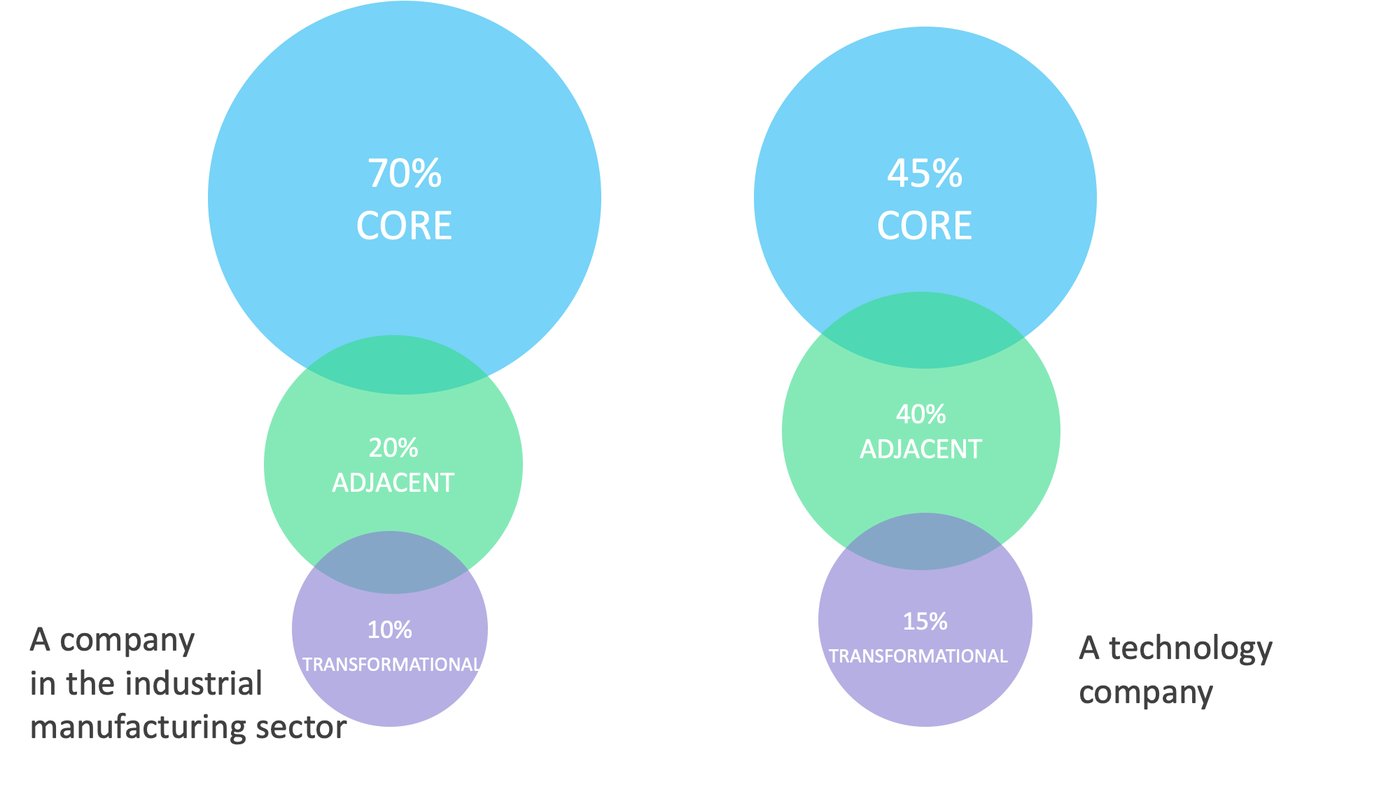What is intrapreneurship and how can it support corporate innovation?
Many companies acknowledge the benefits of encouraging employee initiatives, yet successful intrapreneurship is still the exception rather than the rule. In fact, 70% to 90% of intrapreneurial initiatives in large organizations fail.
Why is that the case, what’s the role of intrapreneurship in large organizations and how can you make it work? In this article we’re addressing the role of intrapreneurship in driving innovation. We’ll also provide some actionable tips on how to succeed with intrapreneurship and how to avoid the common pitfalls that can lead to failure.
Table of contents
 What is intrapreneurship?
What is intrapreneurship?
Before we get started, it’s important to clarify what intrapreneurship is and why it’s an important topic in the corporate innovation conversation.
Intrapreneurship is defined as entrepreneurship inside of an existing company. It refers to the new businesses or ventures created within a large or established organization.
The term was first used to talk about the “dreamers who do”, those who have a hands-on approach to follow their vision and develop their ideas into innovations within an existing corporation.
Intrapreneurship is also about turning attention towards internal capabilities and looking into ways to develop new innovations. At its core, intrapreneurship is about the value people can bring through their entrepreneurial thinking.
Even though intrapreneurs have the same mentality as entrepreneurs, they work in different environments. Entrepreneurs either invest their own finances to the venture or look for investors, while intrapreneurs rely on resources provided by the company which means that the risks are usually smaller.
Intrapreneurs can be a true force in an organization, contributing to change while creating more innovation. But for that to happen, companies should uncover and encourage intrapreneurs.
Now, let’s see why intrapreneurship needs more attention.
Why should organizations support intrapreneurship?
To understand why intrapreneurship plays an important role in driving more innovation we should start by looking at the current Fortune 500 companies.
88% of the organization that made the Fortune 500 list in the 1950s are no longer active or relevant today.
These figures are worrisome and show that companies shouldn’t put all their eggs in one basket.
Instead of solely focusing on improving and optimizing existing business in their current areas of success, they should also try to find new ways of driving and sustaining growth with innovation.
Intrapreneurship has become an important component in corporate innovation and here’s why more organizations should take it into account.
It enables continuous innovation
The first thing to consider is that intrapreneurship drives the development of new products and services. Intrapreneurs operate slightly differently than employees who work by the book.
They are self-starters and go beyond the organization’s core to follow their vision. Intrapreneurs have a hands-on approach to create innovation internally. They pursue their ideas, and they want to be successful and are willing to put in the effort to make that happen.
If your organization has the culture to support these traits, more ideas can see the light of day, and a greater number of innovations can be pursued.
It provides a competitive advantage through continuous organic growth
When it comes to intrapreneurship, it’s important to set the expectations right. It might not be very realistic to think employees in every company can create the next PlayStation or Gmail.
Instead, intrapreneurship is about creating value and a long-term vision. You don’t have to worry about creating a huge new business from the beginning.
Enabling people to take initiatives and providing them with the resources to act as intrapreneurs will allow for more ideas to flourish and new opportunities to arise. In the long term, you will see an organic growth that can put you ahead of your competition.
Even more, the internal organizational dynamics are also impacted, which takes us to the next benefit on the list.
Contribute to an innovation culture
Working in an organization that is openly encouraging ideas and entrepreneurial thinking can be a game changer for employee experience. Your commitment to support intrapreneurship encourages employees to take initiative, be independent and accountable, as well as responsible for their development and growth.
A Deloitte survey showed that a big percentage of Millennials seeks meaning in their work and opportunities for progress. When people are allowed to practice their entrepreneurial skills, they embrace change and become resilient to risks and failure.
Intrapreneurship is rewarding for many employees because it allows them to manifest their creativity. This increases loyalty and helps you retain more of your top employees, which takes us to the next, closely related benefit.
Attract and retain top talent
As many as 70% of entrepreneurs had their idea during a previous job. This can only make us wonder, what would have happened in those companies if their entrepreneurial spirit would have been encouraged internally.
There is a real war for talent, companies fighting for the best employees. But they often fail to support existing intrapreneurs in the organization and don’t encourage their entrepreneurial thinking enough.
When attracting new talent, it’s important to showcase the focus on these traits. Candidates are interested in using their entrepreneurial skills, especially if they can do it in an established organization where risks are lower even if some uncertainty still exists.
Challenges of intrapreneurship
Having seen the benefits, it’s also good to be aware of the challenges that come in the way of intrapreneurship. If you’re not paying attention and don’t put effort into real solutions, intrapreneurs can slip between the cracks.
Leadership commitment
Unlike entrepreneurs, intrapreneurs can’t move things around without approval from higher management. Leaders can become bottlenecks for intrapreneurship and, ultimately, intrapreneurs will get tired of hitting wall after wall and will eventually leave.
If your organization is committed to intrapreneurship, this should be reflected in the processes you create and the incentives you provide, such as freedom and acknowledgment rather than monetary compensations. Management should work to identify intrapreneurs and give them the tools they need to excel.
Time and resources
Like leadership commitment, allocating resources is also a common challenge for innovation in general. Executives know it. There are many things that should be done but there never seems to be enough time or resources to do everything.
In these situations, organizations are tempted to outsource their innovation initiatives, instead of harnessing internal potential. So, their dilemma is whether they should keep their best people where the money is or where it could be in the future.
The entrepreneurial mindset has always been encouraged at Amazon and the results speak for themselves. Their culture encourages curiosity and experimentation, keeping the entrepreneurial mentality alive even when they have 54% of market share. They always choose to look into the future, rather than putting all their money in what already works.
“We need to plant many seeds because we don’t know which one of those seeds will grow into a mighty oak.” – Jeff Bezos.
Competing with internal roadblocks
Unlike start-up ventures that compete with others on the market for investment opportunities, the real test inside a big company is how to secure budget and resources that is usually coming from other areas of the organization. You can’t rely on intrapreneurs having the connections and arguments for securing investment.
Some organizations can block intrapreneurship initiatives because they don’t want to take the risks associated with it. However, risk taking is part of innovation, and there’s no real way around it but to systematically engage as many people in the process so you can dramatically improve your odds of making it work.
Lack of innovation processes
Intrapreneurship can succeed if the organization has a systematic approach of handling, prioritizing, validating, and implementing ideas. This is what we call an innovation management process.
Research on Fortune 100 companies has shown that game-changing innovation requires a company-wide innovation management system. Intrapreneurs can’t succeed on their own if they are not supported by a process of managing, prioritizing, and validating ideas. It’s a myth that intrapreneurs can go from idea to reality on their own.
 Companies need systems and structures that nurture ideas instead of expecting the “hero employees” to push their ideas until someone might pass them on. What happened at Kodak is more common than the success stories of Post-it and Gmail.
Companies need systems and structures that nurture ideas instead of expecting the “hero employees” to push their ideas until someone might pass them on. What happened at Kodak is more common than the success stories of Post-it and Gmail.
When Steven Sasson came up with the portable digital camera at Kodak, his idea was quickly dismissed. The lack of an innovation management process, as well as uncommitted leadership turned into a huge, missed opportunity.
This is a common mistake in many companies. Ideas are dismissed and opportunities are missed. To avoid this, there are some key success factors to keep in mind.
Key success factors for intrapreneurship
Steve Blank was recently explaining why innovation heroes are a sign of a dysfunctional organization. This is what happens with intrapreneurs that struggle inside of an organization. If they are persistent enough, they become the heroes, that against all odds, managed to push innovative ideas further.
However, these heroes need more than a bonus. They need resources, a culture that encourages experimentation and processes for non-standard situations like the one in which intrapreneurs usually operate. These are some of the key success factors for intrapreneurship.
Intrapreneurs need resources, a culture that encourages experimentation and processes for non-standard situations like the one in which they usually operate.
To paint a clearer picture, think of the fact that in a 5000-employee company, 250 people have the potential of becoming innovators. Out of these 250, at least 25 can be great innovators if given the chance.
How to give them that chance? Let’s have a look at some key success factors and practical things you can do to empower intrapreneurs.
Leadership commitment
A bad approach from leadership can be a big road blocker for intrapreneurship, but what is the right approach?
What should you, as a leader, do differently to encourage and sustain intrapreneurship?
- Recognize intrapreneurial traits and be invested in cultivating them in a strategic manner
- Define and communicate the mission and the vision of the organization and show your openness and flexibility to ideas. Emphasize that proactivity and entrepreneurial thinking are valued and rewarded
- Give people creative tasks that relate with their passions and interests. You can encourage them to go beyond their job description and share ideas through an idea challenge around a specific problem that requires creative solutions. This way you can also recognize the intrapreneurs that might not have been visible until then.
- Assign responsibilities and owners. It’s not easy for everyone to share their ideas, especially if they are unsure who’s in charge of taking those further. Ideally, you have an ideation process in place where you assign people responsible for new ideas.
Allocate resources
Intrapreneurs, unlike entrepreneurs have the resources of an established organization. At least in theory.
Organizations should think of intrapreneurship as a capability that needs support, just like the human resources or marketing departments. This also means that clear responsibilities, incentives and development opportunities need to be drawn and included in a process.

There are many things you can do to make sure intrapreneurship gets a piece of the cake too. For example, the 70-20-10 rule of innovation can be a structured way of managing innovation and allocating resources throughout the organization.
This can be a good starting point to distribute resources between the core, adjacent and transformational initiatives.
Build the right culture for intrapreneurship
Culture is one of the biggest roadblocks for innovation performance and a poor corporate culture can also stand in the way of intrapreneurship.
Jeff Bezos was saying that “you can write down your company culture, but when you do so, you’re discovering it, uncovering it – not creating it”. So, a first step is to look at your current culture, its strengths and things that stay in the way of intrapreneurship. Then you can see what needs to be changed in the long term.
"You can write down your company culture, but when you do so, you’re discovering it, uncovering it – not creating it" - Jeff Bezos
Cultural change starts from the top, with leaders committed to take actions required for intrapreneurs to thrive. However, it happens at the bottom where people’s behavior has the real impact on how the organization is performing.
A culture of intrapreneurship should be reflected in the commitment to people, dedication to continuous learning and openness to experimentation. Apple is an example that shows a culture of intrapreneurship in practice.
Their most popular products are the results of a culture that supports creativity, experimentation, and entrepreneurial thinking.
If you want to find out more about creating an innovative culture, we’ve compiled a complete toolkit on this topic so you can dive deeper.
Manage innovation systematically
Innovation management is a very complex topic but also a key element that contributes to intrapreneurship success. Managing innovation in a systematic way will make it easier for entrepreneurs to come up with ideas and for you to prioritize, evaluate and validate them.
For example, companies with an intrapreneurial approach have a decentralized structure where decision making is delegated to the bottom level, so those with the knowledge and ideas can act independently.
It’s important to look into the possible methods and processes that could support your needs and then choose the right tools for the job.
To dive deeper into the possible solutions, we’ve put together a guide that goes through the major processes that support an entrepreneurial organization.
Examples of successful intrapreneurship
An HBR research revealed that only 20% of employees believe that their company encourages entrepreneurial ideas. So even though most companies claim they do encourage entrepreneurial thinking, in reality, few take the necessary actions.
Examples like Google’s Gmail, the Facebook “like” button, and 3M’s Post-it are just a few among many intrapreneurial success stories. It’s interesting to look at how other organizations approach intrapreneurship and what worked for them. So let’s see a few more examples.

-
Société Générale
The 150-year-old French bank is the third largest investment bank in Europe, and even with all the disruptors in the banking sector, they are still relevant today.
To secure their future, Société Générale is betting on innovation as a main strategic function so they created the Société Générale Venture, a €150 m fund. They launched an intrapreneurship program and their start-up call engaged intrapreneurs from all hierarchical levels that lead to the creation of 60 start-ups.
Even though only a couple of those start-ups will make it on the long run, this example shows that intrapreneurship can support change on all levels. The Chief Innovation Officer of Société Générale explains how the program was also a cultural shift for the entire group, giving a completely new pace and scale than the one they were used to.
-
Flamin’ Hot Cheetos
Intrapreneurs can become true inspirations for employees. As long as they are encouraged. Such is the story of Richard Montanez, a janitor who in the 80s came up with the Flamin’ Hot Cheetos idea.
Frito-Lay CEO, Roger Enrico, encouraged all employees to act like “owners” and opened its door to new ideas from employees coming from all walks of life.
The Flamin’ Hot Cheetos has become one of the most successful launches ever for Fritto-Lay and proves that you never know where good ideas can come from.
-
Sony
However, not all leaders are easily convinced and open to new ideas, and then intrapreneurs have to persevere. This was the case at Sony. PlayStation exists today because of a persistent intrapreneur, Ken Kutaragi, who believed in the future of video games.
Even though at first he worked on his own to develop the new game console, he managed to convince Sony to go ahead with his project. Ten years later he was the CEO of Sony Computer Entertainment, the subsidiary responsible for the PlayStation.
Conclusions
To conclude, it’s important to emphasize that intrapreneurship is by no means the ultimate solution for companies willing to innovate. It can’t solve all problems. There are many other elements that make a company more innovative, and intrapreneurship is just one of them.
Most importantly, we should point out that intrapreneurship is not just about doing things a certain way within a specific process. It’s more of a mindset that enables you to think and act in a way that encourages and supports innovation.
Making innovation systematic and part of the organization’s culture takes time and there are different ways to get there. Encouraging intrapreneurship is one of the methods that can boost innovation efforts.
Having said that, keep in mind that intrapreneurship should not be about the hero employees who struggle to bring creative ideas to life. Intrapreneurs have to be supported at an organization-wide level so they can bring lasting results.
To help leaders and entrepreneurial-minded employees drive innovation with intrapreneurship, we've put together a practical guide with tools, tips and methods. You can download the toolkit here.








